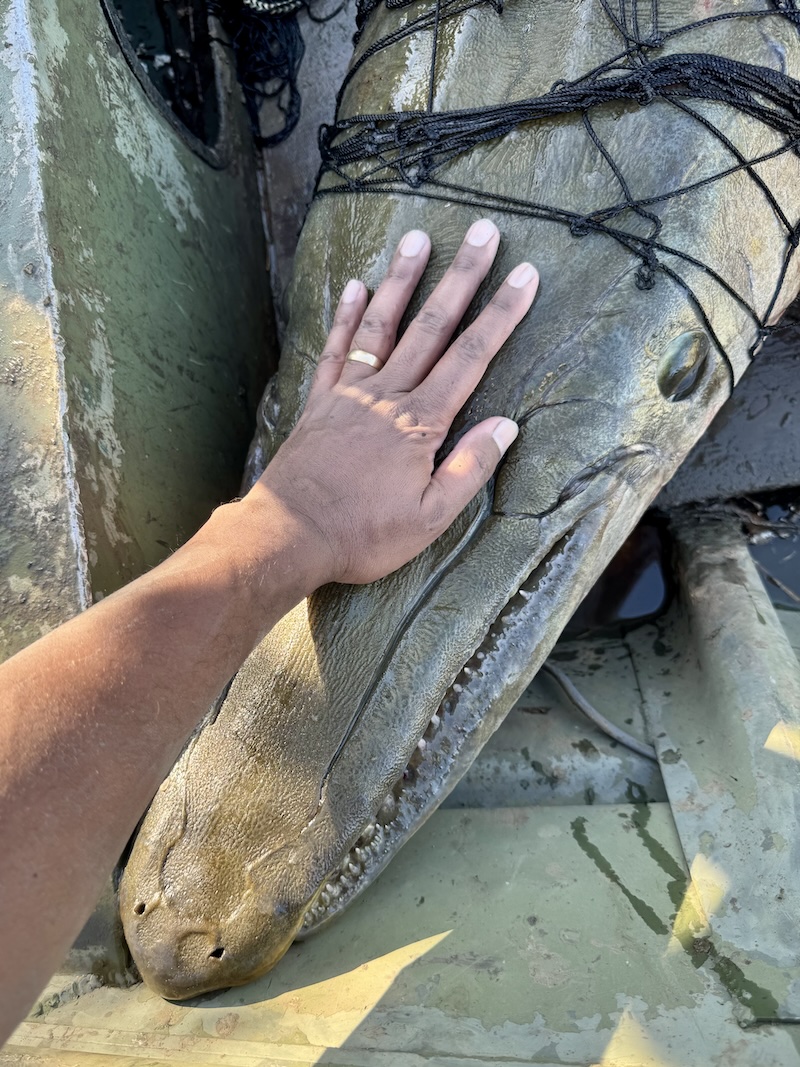Researchers were capturing fish on a recently restored floodplain in Mississippi last month when they tangled with an absolute brute: a 7-foot 10-inch alligator gar with a whopping girth of 55 inches.
Solomon R. David, an assistant professor at the University of Minnesota and a highly regarded gar expert, was leading the scientific effort on October 20th with students and several staffers for The Nature Conservancy, including Scott Lemmons. His team had received guidance from US Fish & Wildlife Service Fisheries Biologist Kayla Kimmel. The researchers were capturing, measuring, and tagging gar on Loch Leven, a floodplain lake of the Mississippi River that had been reconnected thanks to support from The Nature Conservancy and the Farm Bill. The project is especially important for alligator gar conservation, as dams and levees along the Mississippi River Basin have cut off the slow-growing species from spawning habitat.
To capture alligator gar, David’s team uses a special, braided gillnet that reduces mortality. After setting the net, the team watches the floats it’s attached to and immediately pulls the net whenever there’s movement. On the morning of the 20th, David told MeatEater that his team captured a five-and-a-half-foot alligator gar, a six-footer, and even, a seven-footer. Then chaos struck.
“I’m starting to bring up the net, and I just see this gigantic head,” David said. “I knew when I saw it rising from the depths that it was one of the biggest and widest alligator gar I have ever seen.”

David and three other folks used the “burrito method”—wrapping the net around the gar and using it to hoist it—to get the fish into the boat. David said the fish’s flopping was particularly strong as it hadn’t been tired out from a fight, as fish fought on hook and line often are.
“Once we get it in the boat, the fish thrashes, and this thing’s head smacks me in the face, shattering my sunglasses,” David said. “It knocked all four of us down.”

Instead of bringing the heavy fish ashore to conduct measurements, David and his team took measurements while they could with the fish still in the boat. Then they took a genetic sample and tagged it. The fish was seven feet, 10 inches long. More impressively, it had an estimated girth of 55 inches. David estimated its weight at around 300 pounds.
For comparison, the IGFA All-Tackle World Record came in at 283 pounds. That fish was 8 feet, 4 inches long, but may have had a smaller girth than the gar David documented this fall. The biggest gar ever recorded was an 8-foot, 5-incher inadvertently netted by a commercial fisherman in 2011. That fish weighed 327 pounds with a 47-inch girth.

David says that finding such a big gar, which could be anywhere between 50 and 90 years old, at the site of a recent restoration project is a good sign for the broader conservation of the species. “It’s exciting to see that there are giants still left after what we’ve done to these river systems. And it reiterates the importance of these critical ecosystems,” he said. “It’s important that we continue to conserve and restore these floodplain habitats. Seeing these giant fish using them suggests that the restoration projects are effective.”
To release the fish, David said that he and his team had to tilt the boat over to get it back into the water. It swam away safely. “It was just unbelievable,” he concluded. “For someone who has studied these fish for decades, it really was the fish of a lifetime.”
Want to hear more about gar from Solomon David? Check out this recent episode of the MeatEater Podcast.
Read the full article here



